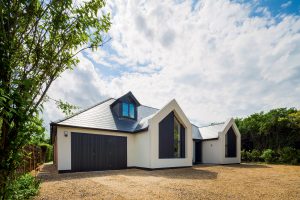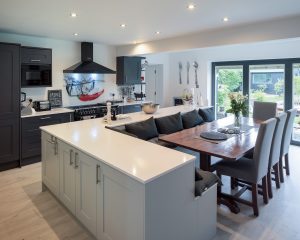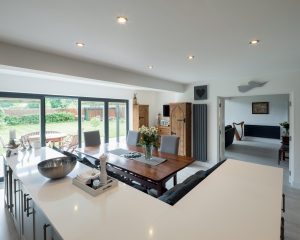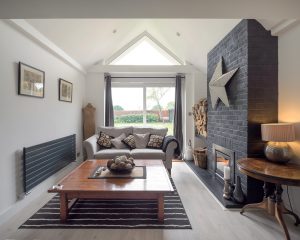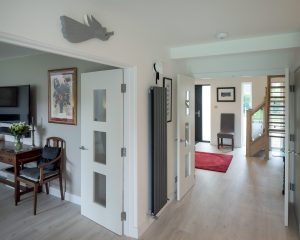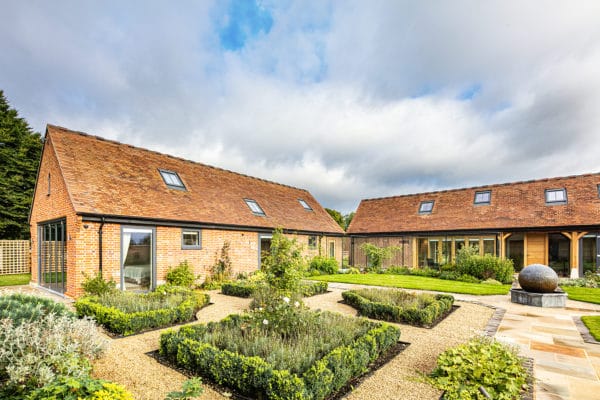1960s Bungalow Transformed into Modern Open-Plan Home
When commercial property developer and chartered surveyor Mark Fernandez was badly hit by the financial crash in 2008, he turned his eyes from big projects to domestic ones. “We ended up selling our house, pulling our three kids out of private school and almost had to start again,” he says.
His first new venture came about in 2011, when his wife Stephanie spotted a fish and chip shop for sale. “We converted it into a four bedroom house, semi-project managing it ourselves and learning from all the usual mistakes along the way.”
Their next undertaking was an eco self-build, which featured an airtight structure and renewable tech. “I had a desire to do something green and went as far as I could with my budget – we were very close to being zero carbon,” says Mark.
So when they came across a 1960s bungalow for sale ripe with renovation potential, they knew they had the skills needed to transform it into something special. “My wife has an eye for design detail and I’ve got my property background, so we’re quite a good team,” he says. “We wanted a decent sized plot in a semi-rural location – this was perfect.”
Coming up with designs
The previous owner was an architect, who put his stamp on the building in the late 1980s – but it was now looking dated and the layout didn’t suit the needs of 21st century family life. The entrance hallway was small and the kitchen was located in one of the front north-facing rooms, with two living rooms and a conservatory to the rear. “We gave it a lot of thought as a pair,” says Mark. “I sketched out our ideas and then Stephanie took it away and shared her thoughts.”
The internal layout was to be completely changed to create more of an open-plan scheme, the heart being a spacious, light-filled kitchen-diner at the rear. This was maximised thanks to a new extension and a wide span of glazed doors opening the room onto the garden.
- NamesMark & Stephanie Fernandez
- LocationWindsor, Berkshire
- Type of projectRenovation & extension
- StyleContemporary
- Construction methodBrick & block
- Land cost£720,500 (purchased 2016)
- House size271m²
- Project cost£275,000
- Project cost per m²£1,015
- Total cost£995,500
- Build durationSix months
- Current value £1,300,000
Towards the front of the house, a bathroom and WC were to be removed to make way for a large hall space, featuring a cantilevered staircase and providing a sense of openness that would flow throughout the house.
Externally, the shape of the property would stay largely the same, but transformed with contemporary finishes. The gable arches were to remain, enhanced with spans of modern glazing bordered with a bold render in fresh white – a new covering to hide the red bricks across the front and rear elevations. Dark roof tiles and window frames would contrast with the render to create a striking monochrome look.
Planning permission
The couple worked alongside an architect to come up with the designs and engaged planning consultants Pegasus Group to aid the process of submitting the application. “My commercial background means I understand how to deal with planning, but residential has been relatively new to me,” says Mark.
A member of the local planning office visited the house to discuss the plans in what seemed like a very positive conversation; however, after he went back to talk it over with his colleagues, Mark and Stephanie had a call saying it looked like their plans were going to be refused.
“They didn’t want me to extend at all, but I rushed back to the property, thought about where we could reduce the additions and emailed over my sketched out thoughts straight away,” says Mark. “We went to appeal on our previous project and it took 18 months of time, money and anguish to get permission, so we didn’t want to go down that route again.”
The planner asked them to get the new plans worked up within the next 10 days, while he was on holiday, so that on his return he could look to approve them within the two days left before he had to say yes or no. Luckily, it all worked out for the Fernandezes.
“The property is positioned within a designated greenbelt area, so I don’t think we’d have been granted permission if we hadn’t engaged the skills of a planning expert,” says Mark. “We got there through sensible advice and knowing where compromises could be made; we liaised with every neighbour and nobody objected.”
Project management
With the application approved before exchanging the bungalow, the couple had time to line up all the trades to get started from day one of owning the property. Two days after formalising contracts the team was in, stripping everything back. Although several trees had to go, they tried to recycle as much as possible – a silver birch tree that had to be removed has now become the shrub borders, for instance.
The aim was always to create something different to a run-of-the-mill house, and this was at the forefront of Mark and Stephanie’s minds when specifying products. They did lots of online research and travelled to visit companies in person.
They also attended numerous self-build shows. “These are vital for anyone creating a bespoke home – even if you spot one thing then it’s worth it, and we always found something,” says Stephanie.
Mark decided to take on the role of project manager, putting a line through his diary from October through to the end of April to commit as much time as possible to the renovation. “Throughout my career I’ve been used to assembling a huge team around me to do things
on my behalf rather than being the person on site making decisions – I’d never got my hands dirty before 2011,” he says.
“I’ve learnt to get stuck in and that delegating isn’t always right, especially when
it’s your own home. I was there every day, encouraging everyone on site, keeping them motivated, making sure they turned up, telling them they’re doing a good job and building on teamwork.”
Mark kept everything under control via detailed spreadsheets, understanding exactly how much money was going out to ensure balanced cash flow – especially important as the family continued to live in their home during the works rather than selling to finance the build.
“Owning two houses meant we needed to be efficient,” he says. “We were realistic with timings, allowing six months. We probably could have done it in four and a half but we didn’t want to rush it; I wanted our team to do a high quality job. I like working with good people, who I can form a decent relationship or even become friends with; it’s important to have a team that comes together.”
They were also under the constraints of having teenagers revising for upcoming GCSEs and A Levels, so they didn’t want to potentially compromise the children’s ability to study at home by moving house at the wrong time.
“We set the schedule to move at Easter when the kids weren’t in school,” says Mark. “Others race to the finish line because of funding, but we felt like we had to complete the project before moving and just find ways of getting the money. Thanks to BuildStore and others we managed to keep things afloat.”
Build budgeting
The couple recognised the importance of having a contingency fund, which was just as well as it was soon dipped into. “Always add a month to your timings and 10-15% to your budget,” says Stephanie.
Mark recognised that, no matter how organised you are, there are always details that go unnoticed and cause complications. “When you’re project managing every day, sometimes you suddenly spot something in the house that you hadn’t on the original plans,” he says.
The first unexpected hurdle was to do with their hot tub. It was fitted into its sunken position before the winter, but the family hadn’t realised the water table would be as high as it was – something they discovered before they got round to having the area tanked. “Water had been leaking through the side the whole time and had broken the electrics, so it had to be replaced,” he says.
Then, it turned out that the calculations for their cantilevered staircase had been incorrect – but unfortunately they didn’t notice until after the bespoke oak flight arrived on site.
“Conceptual designers don’t always appreciate detailed schemes,” says Mark. “Extra costs can be incurred due to the need for significant structural change arising from a flawed design.” The couple had to order a new one, but tried to make use of the original treads where possible, some of which now feature in window sills and bookcases.
Another frustration was down to the glazed doors in the kitchen. The couple faced numerous problems with the supplier, who they felt offered terrible customer service. What should be an efficient folding sliding system working on magnets didn’t operate properly when originally fitted.
The installation was delayed, then a door actually fell off and, due to a fault with the screws, the whole system had to be replaced – something the supplier didn’t do until over six months had passed. “We did our research and saw the product in person, but you can still make mistakes,” says Mark.
A bright, energy-efficient home
Mark and Stephanie wanted to renovate this property into their forever home, and that meant making a pleasant environment that was warm and filled with daylight. They packed extra insulation in to minimise heat loss and included ample glazing.
One of the couple’s favourite features is the amount of natural illumination that filters throughout, as well as how quiet and private the property feels. “I love being in my bedroom or study where the light streams in,” says Mark. “Also, we’re near Heathrow with a road right outside but all we can just about hear is the fridge humming.”
Being a sociable family, another key aim was for an open-plan living space suitable for entertaining, the hub being the kitchen. Its design centred around integrating an oak table that the couple had owned their whole marriage. Bespoke seating was designed into the kitchen to form the dining space.
“We knew exactly how we wanted it to look – we could see it almost down to the last cupboard,” says Mark. “We actually had to adjust the design at the last minute after we’d ordered it, but the company was brilliant and happily made changes at no extra cost; it could have been an expensive mistake.”
Reflecting on their project, Mark and Stephanie understand that the process of creating a bespoke home is all about balancing the vision, compromises and indulgencies. This venture centred around the desire for somewhere they could enjoy together as a family and the small details were important to them.
“We’ve been fighting since we got knocked back in 2008 and we’ve created a place our children can enjoy and remember,” says Mark. “There are days when it all goes wrong, but what’s great is that you’re creating a product for your family. We’re a unit and have come together as a team; for us I think it’s been a journey we’ve all shared and worked towards. We made errors along the way, but we’re still here smiling.”
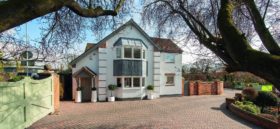
































































































 Login/register to save Article for later
Login/register to save Article for later


